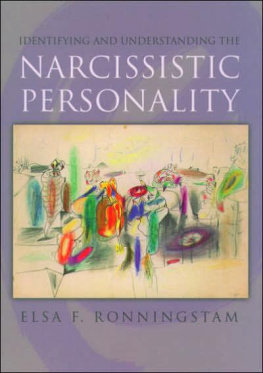The Antecedents
Paradoxically, the Narcissus myth by Ovid ( Melville, 1986, pp. 6166 ), which in our time has come to represent self-love or self-reflection, actually described the tragic inability to love at all ( Winge, 1967 ). It is the story of a beautiful young man, son of the river nymph Liriope and the river god Cephisus, whose destinyto die young if he gets to know himself-had been early prophesied. Because of his cold, hard pride, Narcissus could not be touched by the many young boys and girls who loved him, not even by Echo, whose heart was fired by the sight of him. When Narcissus fell in love with the image in the pool, he mistakenly took it for a real body and did not understand that it was a reflection of his own body. In other words, Narcissus could not conceive that he was in love with his own reflection; he was caught in an illusion. All efforts to converse with the unreachable image in the spring left Narcissus disheartened and filled with despair. Finally he realized: I am he! Oh, now I know for sure the image is my own; it's for myself I burn with love; I fan the flames I feel ( Melville, 1986, pp. 6465 ). Heartbroken, he wished he could separate himself from his own body so that the image he loved would go away. He then sensed that death was the only solution as now we twoone soulone death will die (p. 65). He faded away, and when the nymphs came to bury his body, they found a flower at its place.
How the narcissus myth came to represent self-love or self-admiration is unclear, but in art and literature during the medieval and early Renaissance eras the theme was used to illustrate the dangerous sinfulness and [Page 4] deadly punishment attached to excessive self-preoccupation and selfadulation. Calderon de la Barca in the seventeenth century was the first to transform the classic description of Narcissus into a modern interactive stage play about the young man in Eco y Narciso ( Echo and Narcissus ; de la Barca, 1661/1976 ). Calderon moved away from moral condemnation of excessive self-love and created a dynamic outline of Narcissus ( Gran, 1976 ). He explained Narcissus's love of his own reflection not as selflove but as a flight, a consequence of incompatible conflicts and desires in a young man, still attached to his domineering and protecting mother, confused by Echo's alternation between seductive invitation and mute rejection, and torn between warnings and ill-fated male advice. In other words, Calderon de la Barca introduced an interpersonal perspective to the Narcissus myth, and he was the avant-garde to what later was defined as narcissistic affect dysregulation, as he staged Narcissus's struggle with sudden intense and overwhelming sexual feelings, inner pride, and shame and confusion. With no natural outlet for his strong feelings, Narcissus turned to himself and his image in the spring, and died.
Another Spanish writer, Juan Valera, who was closer to modern thinking on narcissism as autoerotic self-love or admiration, described in his novel Genio y Figura (1897) the heroine Rafaela. She confessed that when looking in the mirror she was filled with love and admiration for herself, and she imitated Narcissus and kissed her own beautiful image on the surface of the mirror. But contrary to Narcissus, Rafaela was fully aware of the separateness of her own physical body and self from the image of her body she perceived in the mirror. She was also fully capable of experiencing pleasure. Valera's novel inspired both Havelock Ellis and J. Sadger in their psychological and psychoanalytic accounts of narcissism and female autoerotism ( Ellis, 1928, pp. 352, 355 ).
The Narcissus theme has also inspired numerous artists. One of the earliest known attempts to portray Narcissus appears in a wall painting in Pompeii. During the Renaissance, several artists chose Narcissus to illustrate self-love, self-admiration, and the contemplation of one's own image. Caravaggio's Narcissus and Velasquez's and Titan's portraits of Venus are well-known examples. It is notable that the young Narcissus was gradually replaced by images of women who represented the fatal sin of self-admiration and vanity. In many paintings, among others by Baldung (sixteenth century), attractive women looking at themselves in the mirror are threatened by figures representing Death. In the twentieth century, the theme became one of mirroring and preoccupation with appearance, [Page 5] self-recognition, and self-regard, as in Norman Rockwell's Girl in the Mirror and the etching titled Adolescence by the British artist Gerald Leslie Brockhurst. The themes of reflection and mirroring were specifically featured in an exhibition, Mirror Image, at the National Gallery in London and further discussed in an accompanying book by J. Miller (1998) .
Early Psychiatric and Psychoanalytic Development
Ellis (1898) introduced the phenomenon of narcissism to psychiatry in his psychological study of autoeroticism, in which he described the Narcissus-like tendency to absorb sexual feelings into self-admiration (p. 280). The following year, Paul Ncke (1899) was first to use the term narcissism in a study of sexual perversions. Freud first mentioned narcissism in a footnote added in 1910 to Three Essays on the Theory of Sexuality ( Freud, 1905/1957 ), as a phase in the development of male homosexuality. In 1911 ( Freud, 1911/1957 ) he referred to narcissism as the choice of self as a libidinal object, a normal stage of autoerotism in the early libidinal development. The concept was by then acknowledged among psychoanalysts, and in subsequent accounts narcissism was considered both a part of normal development and human functioning and a type of deviation or perversion.
In the first psychoanalytic paper on narcissism, Rank (1911) discussed the development of self-love, specifically expressed through a woman's dreams and her experience of being unable to love a man unless she first knows that he loves her. Freud, in his main paper on the subject, On Narcissism (1914/1957) , and in his later comments ( 1915/1957 , 1917/1957 ), outlined definitions of primary and secondary narcissism, identified narcissistic object choice, and connected narcissism to the development of the ego-ideal and to self-preservation and self-regard as the libidinal complement of egoism. Another important observation of much relevance for the contemporary discussion of narcissism concerned the relationship between narcissism and inferiority. Freud suggested that the impoverishment of the ego due to the withdrawal of libidinal cathexis (investment of sexual drive energy) contributed to feelings of inferiority. In addition, he identified the role of narcissism in sleep and dreams and in the process of falling in love. Sadger (1910) , another European psychoanalyst, viewed narcissism as a normal phenomenon, an overvaluation of oneself seen in children and in a certain degree of self-love among adults, but its fixations and extreme manifestations, such as the overvaluation [Page 6] of one's own body, he considered to be pathological. He differentiated between normal egoism and narcissism, and suggested that friendship is an extended form of narcissism. The first American discussion on narcissism took place in 1915 in New York, at the sixth annual meeting of the American Psychopathological Association (1915) . The program included a paper by J. S. Van Teslaar titled Narcissism.
The connection between narcissism and self-esteem regulation, first alluded to by Freud in his discussion of self-regard and the development of the ego-ideal ( 1914/1957 ), was further developed by Horney (1939) , who differentiated healthy self-esteem from pathological unrealistic self-inflation, a substitute for an undermined self-esteem. Anne Reich (1960) added considerably to the understanding of pathological self-esteem regulation, which, in her opinion, serves to maintain grandiosity and undo feelings of inadequacy and insufficiency. She described the strategy of compensatory narcissistic self-inflation, which fails and results in hypochondriac anxiety and depression. Excessive inner aggression and inordinate self-consciousness leading to dependency on outside approval contribute to these regulation failures. Kohut (1971) identified defects in self-esteem regulation as one of the core disturbances in narcissistic personality disorder (NPD), and Goldberg (1973) proposed a separate diagnostic category of acute narcissistic injury to one's self-esteem that may manifest itself as depression but should be differentiated and treated differently from general depressive reactions or disorder.











